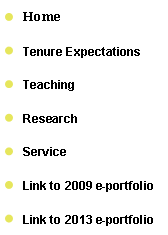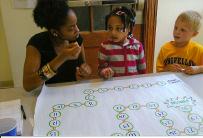


|
EDUC 364: Elementary Math Methods |
|
This page highlights significant changes to the course and “fresh evidence” produced since my first pre-tenure review. Please refer to the EDUC 364 page on the 2009 e-portfolio for additional materials from this course. Indeed, the 2009 e-portfolio includes a sample of student work connected to the embedded kindergarten teaching experiences at Longfellow Elementary School. These “teaching labs” are considered the most important learning experience in the course, so the sample of student work in the 2009 e-portfolio provides essential artifacts related to the teaching and learning that occurs in EDUC 364. During the 2010-2011 academic year, the Education Department reorganized the elementary education major. The changes affected my teaching responsibilities beginning with the 2011-2012 year as follows: (1) the 2-credit Computers in Education course I teach would no longer be a requirement for elementary education majors; (2) the Elementary Math Methods course (EDUC 364), formerly a 2-credit course, would become a 3-credit course; (3) the expectation for utilizing that extra credit in EDUC 364 was to integrate technological applications relevant to elementary teachers into the course. The work samples on this page relate to the new technological components introduced to the course in Fall 2011. An interesting course assignment this term was not carried over from the old Computers in Education course, but was a completely new assignment tailored to the needs of Augustana elementary education majors specifically. Our department required all junior elementary education majors to purchase iPads for the 2011-2012 year. The rationale for this is that Longfellow Elementary has purchased dozens of iPads for their students’ use. Since our juniors engage in clinical work at Longfellow throughout the year, we felt that the Augie students would be better integrated into the school if they had their own iPads. In the math methods course, then, one of my responsibilities was to expose my students to how the iPad might be used in elementary mathematics instruction. As I prepared to do this over the summer, I quickly realized that thousands of mathematical apps are available on the market, but the quality of these apps varies significantly. Furthermore, I searched the internet extensively over the summer for a reputable website that might list high quality apps that are aligned to the required Common Core teaching standards, but no such site exists. All of this searching in vain made me decide that my EDUC 364 students and I would pioneer this kind of web-based resource. This was accomplished via the iPad App Evaluation assignment. For this assignment, each member of the class was assigned two mathematical apps to purchase and evaluate. Evaluation criteria were established in advance using a set of guidelines provided in the course textbook. After the evaluation process, we spent a class day presenting the apps to each other and sharing our evaluations of the apps. Apps that were deemed worthy of recommendation were posted to a collaborative Google site I created (named ATTACC: Augustana Touch screen Technology Aligned to Common Core). Augie students posted public feedback about all apps (good and bad) to iTunes as well. I anticipate continually developing the ATTACC site with my students into the future, and I found the project so interesting and potentially useful to others in my field that I have submitted a speaking proposal to the National Council of Teachers of Mathematics pertaining to this work. The iPad App Evaluation work sample includes the assignment description, the scoring rubric that I used to grade student work on the assignment, and samples of student work judged to be strong, average, and weak. An additional technological assignment that did carry over from the old Computers in Education course is the SMARTBoard Presentation. It is evident that Augustana pre-service teachers must have interactive whiteboard skills as they move into the work place. When I arrived at Augie in 2008, there were no SMARTBoards in the K-12 classrooms I observed as part of my student-teaching supervision responsibilities. During the fall of 2011, all four of my supervisees taught in classrooms with SMARTBoards. Graduates inform me that they are usually asked in interviews if they have experience with this technology. As Augie’s elementary education majors will no longer take the Computers in Education course, the introduction to the SMARTBoard has been moved into EDUC 364. The SMARTBoard Presentation work sample includes the related assignment description, the rubric I used to assess student presentations, and samples of student work judged to be strong, average, and weak. (Note that the work sample is a PDF file, while the original student work was created using Notebook software. The original student work is linked to within the PDF. Reviewers will need Notebook software to view the original student work, but will be able to read all other material including my evaluative comments with a PDF reader.) |
|
Augustana junior Alannah Golden teaches a lesson about the number sequence with two kindergarteners. ED364 students are required to assess children’s learning, plan lessons, and teach the lessons on a weekly basis throughout the term. |


|
Mike Egan Assistant Professor of Education |

|
Course Documents
Syllabi
Student Work Samples
Student Ratings of Instruction Fall 2009 Quantitative Summary Fall 2010 Quantitative Summary
|